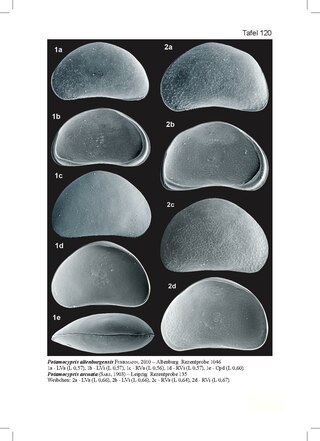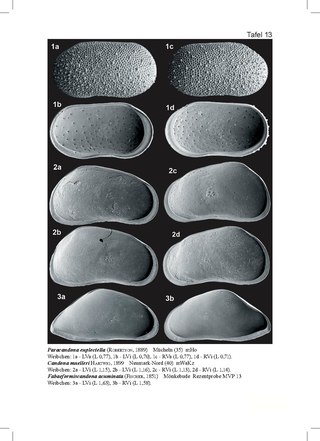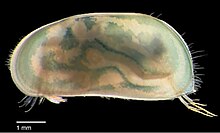
Ostracods, or ostracodes, are a class of the Crustacea, sometimes known as seed shrimp. Some 33,000 species have been identified, grouped into 7 valid orders. They are small crustaceans, typically around 1 mm (0.04 in) in size, but varying from 0.2 to 30 mm in the case of the marine Gigantocypris. The largest known freshwater species is Megalocypris princeps, which reach 8mm in length. In most cases, their bodies are flattened from side to side and protected by a bivalve-like valve or "shell" made of chitin, and often calcium carbonate. The family Entocytheridae and many planktonic forms do not have calcium carbonate. The hinge of the two valves is in the upper (dorsal) region of the body. Ostracods are grouped together based on shell and soft part morphology. While early work indicated the group may not be monophyletic and early molecular phylogeny was ambiguous on this front, recent combined analyses of molecular and morphological data suggested monophyly in analyses with broadest taxon sampling, but this monophyly had no or very little support. They have a wide range of diets, and the class includes carnivores, herbivores, scavengers and filter feeders, but most ostracods are deposit feeders.

The Podocopida are an order of ostracods in the subclass Podocopa. It is the most diverse of the five orders of ostracods, and the only one with freshwater species. The group also has a rich fossil record.
Polycopidae is a family of marine ostracods. Its members are related to animals in the suborder Halocypridina, but are sufficiently distinct to be placed in the sub-order Cladocopina. There is even some speculation that a separate order may be warranted. The genera in the family differ from the other suborder, Halocypridina, in several features: the central adductor muscle scars are in a triangular or half-rosette pattern, they lack sixth and seventh limbs, and the maxilla has both an exopod and endopod.
Kapcypridopsis is a genus of ostracod crustaceans in the family Cyprididae, subfamily Cypridopsinae. It includes the critically endangered species Kapcypridopsis barnardi.
Leucocythere is a genus of ostracods in family Limnocytheridae. It contains at least the following species:
Limnocythere is a genus of ostracod crustaceans in the family Limnocytheridae. It contains the following extant species :
Liocypris grandis is a species of ostracod which was long presumed extinct. It was rediscovered in the Western Cape of South Africa in 2003, having not been seen since its original description by Georg Ossian Sars in 1924. It was assessed as extinct for the IUCN Red List in 1996, and that assessment has not been updated.
Newnhamia is a genus of ostracods. It contains five species, four of which are endemic to Australia and surrounding islands, while a fifth was described in 2003 from Kerala, India. Two species from South America, described as species of Newnhamia, do not appear to be closely related to the remaining species, and probably belong in a different genus. N. fuscata and N. insolita are both listed as vulnerable species on the IUCN Red List.

Cypridinidae is a family of ostracods. About half of all known species are bioluminescent. Some use the light only for defence, others also for courtship displays. The lineages with sexually dimorphic bioluminescent displays have more species other lineages, which indicates that bioluminescent courtship could increase the diversification rates.
Cytherellidae is the only living family of the ostracod order Platycopida. Eyes are absent. It contains 11 genera:

Candonidae is a family of ostracods, containing around 25% of all known species of freshwater ostracods. Around 75% of genera in the family are endemic to a single zoogeographic region. It contains more than 500 species, of which more than 300 are endemic to the Palearctic realm.
Limnocytheridae is a family of ostracods, containing the following genera:
Bennelongia is a genus of ostracod crustaceans in the family Cyprididae. It is probably endemic to Australia and New Zealand, and is predicted to be highly diverse. The genus was described in 1981 and named after Woollarawarre Bennelong, the first aboriginal to have a long association with the early European settlers of Australia. Prior to 2012, six species were described in Australia. There are currently 15 species of Bennelongia. Bennelongia may be the last true descendant genus of the Mesozoic lineage of Cypridea, which was a dominant lineage of ostracod in non-marine waters in the Cretaceous.
Potamocypris is a genus of ostracod crustaceans in the family Cyprididae. There are currently 44 extant species of Potamocypris. The majority of the species occur in freshwater habitats; only a few species of the genus colonize marine brackish coastal waters.

Potamocypris mastigophora is a species of ostracod crustacean in the family Cyprididae, subfamily Cypridopsinae. It is known from Africa and the southern areas of the Palaearctic.
Potamocypris unicaudata is a species of ostracod crustacean in the family Cyprididae, subfamily Cypridopsinae. It is abundantly found in ditches and ponds near the sea shore, where freshwater slightly mingles with sea water. It is known from both Europe and North America.
Potamocypris smaragdina is a species of ostracod crustacean in the family Cyprididae, subfamily Cypridopsinae. It is known from both Europe and North America.

Potamocypris arcuata is a species of ostracod crustacean in the family Cyprididae, subfamily Cypridopsinae. It is mainly known from the southern areas of the Palaearctic.

Candona is a genus of ostracods in the family Candonidae.
Chlamydotheca is a genus of freshwater ostracods in the family Cyprididae. About 36 species are known to occur throughout continental waters. Four species are found in Argentina.






